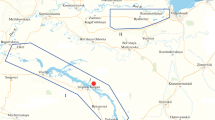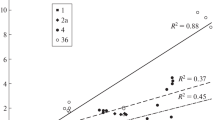Abstract
We estimated the productive potential of methane in paddy soils by anaerobically incubating soils in the laboratory. In addition, we determined the emission fluxes from the rice paddies through rice plants during the whole growth period, according to the methods suggested by Cicerone & Shetter (1981). The results showed that the total amounts of methane emission from rice paddies were very close to the productive potential of the soils and suggested that the large parts of methane emitted from rice paddies originated from the productive potential of methane.
Similar content being viewed by others
References
Cicerone R J & Shetter J D (1981) Measurements in rice paddies and a discussion. J. Geophys. Res. 86: 7203–7209
Cicerone R J, Shetter J D & Delwiche C C (1983) Seasonal variation of methane flux from a California rice paddy. J. Geophys. Res. 88: 11022–11024
Cicerone R J & Oremland R S (1988) Biogeochemical aspects of atmospheric methane. Global Biogeochem. Cycles 2: 299–327
Ehalt D H & Schmidt U (1978) Sources and sinks of atmospheric methane. Pageoph. 116: 452–464
Kimura M, Miura Y, Watanabe M, Katoh T & Haraguchi H 1991 Methane emission from paddy field (Part 1). Effect of fertilization, growth stage and midsummer drainage: Pot experiment. Environ. Sci. 4: 265–271
Koyama T (1953) Measurement and analyses of gases in sediments. J. Earth Sci. Nagoya Univ. 1: 107–118
Koyama T (1963) Gaseous metabolism in lake sediments and paddy soils and the production of hydrogen and methane. J. Geophys. Res. 68: 3971–3973
Koyama T (1964) Biogeochemical studies on lake sediments and paddy soils and the production of hydrogen and methane. In: Miyake T & Koyama T (eds.) Recent Researches in The Fields of Hydrosphere and Geochemistry: 143–177. Maruzen, Tokyo, Japan
Murase J, Kimura M & Kuwatsuka S (1993) Methane production and its fate in paddy fields. III. Effects of percolation of methane flux distribution to the atmosphere and the subsoil. Soil Sci. Plant Nutr. 39(1): 63–70
Sass R L, Fisher F M, Harcombe P A & Turner F T (1991) Mitigation of methane emission from rice fields: Possible adverse effects of incorporated rice straw. Global Biogeochem. Cycle 5: 275–287
Shütz H, Holzapfel-Pschorn A, Conrad R, Rennenberg H & Seiler W (1989) A 3-year continuous record on the influence of daytime, and fertilizer treatment, on methane emission rates from an Italian rice paddy. J. Geophys. Res. 94: 16405–16416
Watanabe A, Satoh Y & Kimura M (1995) Estimation of the increase in CH4 emission from paddy soils by rice straw application. Plant Soil 173: 225–231
Yagi K & Minami K (1990) Effect of organic matter application on methane emission from some Japanese paddy fields. Soil Sci. Plant Nutr. 36: 599–610
Author information
Authors and Affiliations
Rights and permissions
About this article
Cite this article
Koyama, T., Kimura, M. Methane emission fluxes from rice paddies and the methane productive potential in the soils. Nutrient Cycling in Agroecosystems 49, 129–138 (1997). https://doi.org/10.1023/A:1009750106640
Issue Date:
DOI: https://doi.org/10.1023/A:1009750106640




